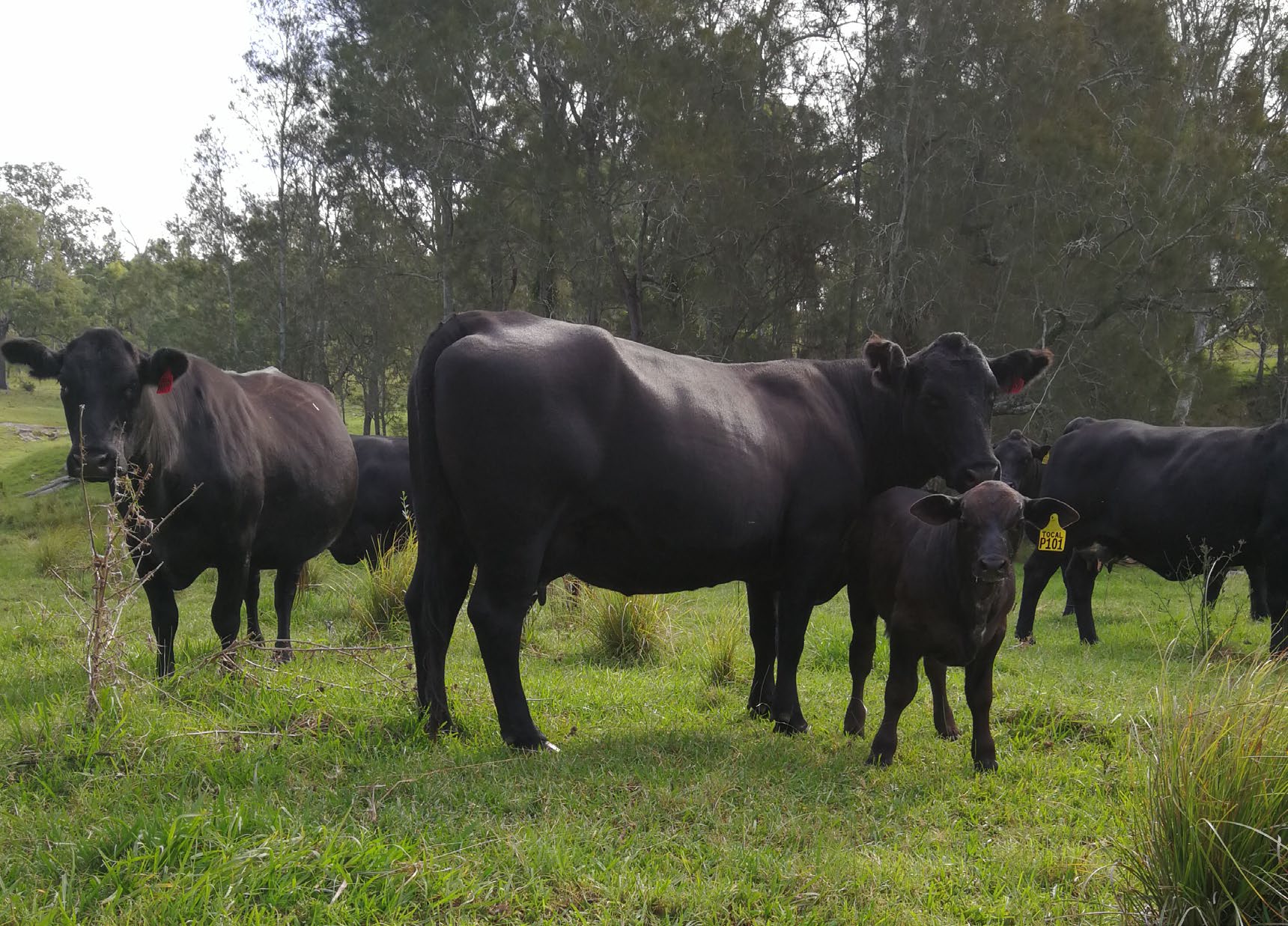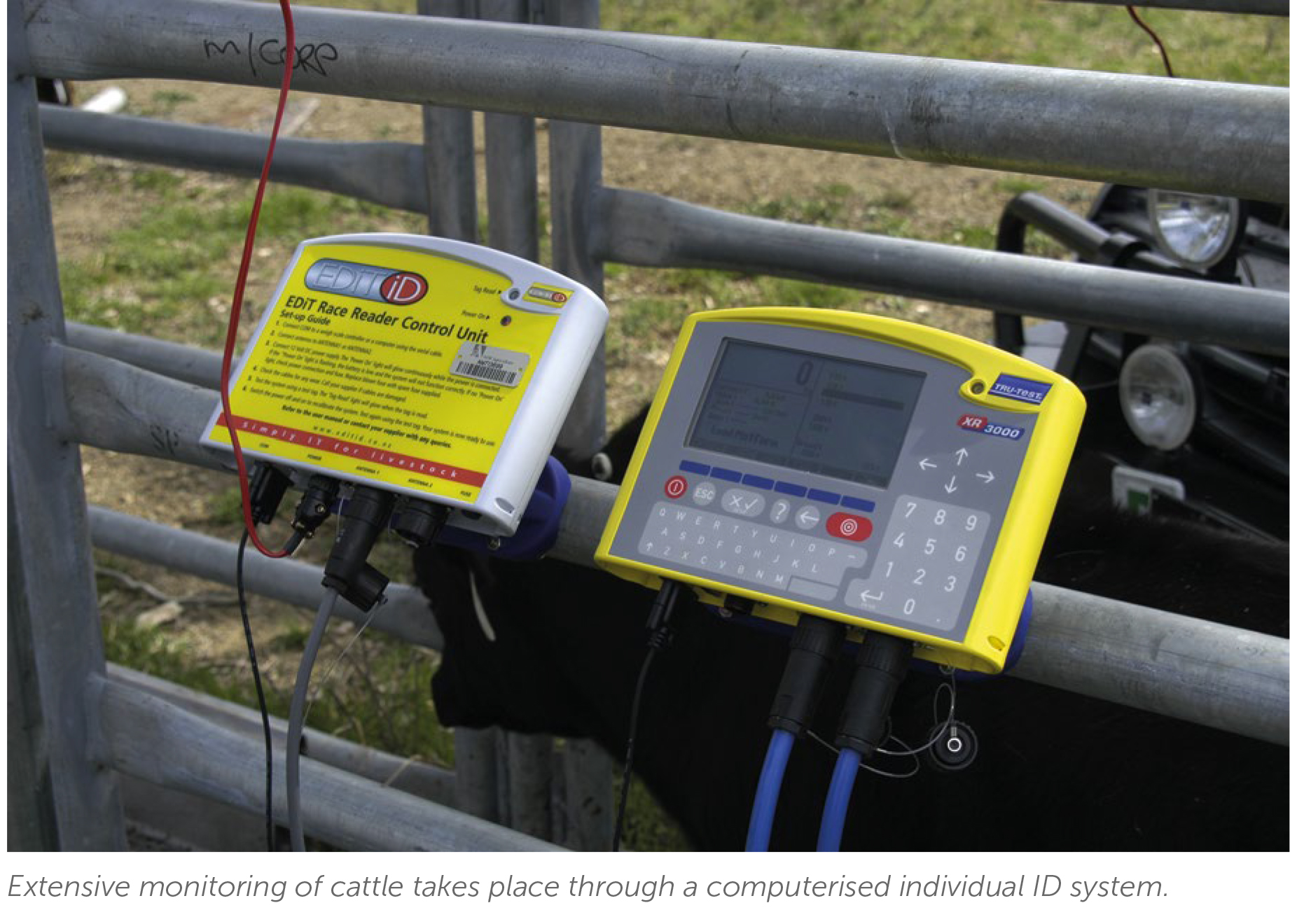Fast Facts
Area - 1790 hectares, made up of prime pasture, medium pasture and
poor pasture land as well as bushland. 10 km from front
boundary (the Paterson River) to the back boundary and
approximately 2 km across.
Herd - Average 1100 head – ranging between 800 and 1400
depending on the time of the year and seasonal conditions.
December 2019 statistics
| Cows | 372 |
| Heifers | 244 |
| Calves/Weaners | 198 |
| Steers | 76 |
| Bulls - Beef | 14 |
| Total | 904 |
Cows/breeding herd - Average 300 Brangus, 103 Shorthorn, 102 Angus, 74 Charolais
Bulls - 10 Brangus, 4 Shorthorn, 4 Angus, 3 Charolais
Market - Sale of yearlings on local stores market – around 450 head per year
Calving - Mainly in Spring. 93% calving, 90% weaning
Fencing - 85km, 5km of fencing was carried out in 2020 including upgrades and subdivision of several larger paddocks
Paddocks/Dams - 49 paddocks, 46 dams and lagoons
Roads - 40km roads and formed tracks
Rainfall - 950mm (40”) on average.
For more images taken on the Tocal farms go to our Tocal Farms Flickr album https://www.flickr.com/photos/tocalcollege/albums/72157664513318258
For videos about the Tocal farms go to our YouTube channel (NSW SPI Schools Program) https://www.youtube.com/playlist?list=PLCw_zxSFv4qdluVIhRWpM6R39KFqro5BA
Details
The area includes a well-balanced mix of grazing country including:
- 609ha of heavily timbered country,
- 590ha native/naturalised pasture,
- 421ha improved pasture and
- 403ha degraded improved pasture.
Herd size and composition
In July 2020, a five-year beef multi breed research program officially began. This is known as Beef Southern Multi Breed Program (SMP) and is a $7m project funded by Meat and Livestock Australia with significant support from NSW DPI, UNE Armidale and the Australian Genetics and Breeding Unit. The project will involve up to 2000 breeding cows from six breeds: Hereford, Shorthorn, Angus, Charolais, Brahman and Wagyu and will be operated across five DPI sites: Glen Innes, Grafton, Trangie, EMAI and Tocal.
During 2019 at Tocal we started setting up with 105 Shorthorn cows and 101 Angus cows, with 25 Charolais. These cows are in a breeding program to calve next year and then enter the project officially from 1st July.
This project will continue at Tocal until 2025 and as a result of this research, cattle operations across the country will be able to compare and select genetics to use in their herds from across all these breeds with confidence.
The establishment of this research program required a reduction in numbers of the Tocal Brangus herd in order to be able to accommodate and feed the animals in the research mobs.
In previous years the beef enterprise has centred on a breeding herd of around 550 female Brangus. In 2019 that number was reduced to around 250 due to seasonal conditions and to allow for the SMP cows. The Beef Southern Multi Breed Program cows, introduced during the winter took our total number of breeders to 480. A total of up to 1400 head can be on hand at Tocal when calves, heifers and bulls are included.
About 80 weaners from the autumn calving program will be fed through to feedlot entry weight as there looks to be a reasonable return on this.
Market
In 2019 the strategy for the selling program on the Brangus herd changed regularly due to ongoing market variability, weather and feed availability on Tocal. During this period there was a lot of variability in markets with a dip in prices due to prolonged dry right across Australia with a steady decline in cattle numbers nationally. As the year progressed cattle prices rebounded due to the strength of the international market. Total sales of $658,275 were up on last year due to carryover of weaners and better overall sale prices.
The major market focus this year will be sale of weaners straight of their mothers as approximately 8 months as the store market (cattle that are sold to be fattened by someone else) is strong. All steers (castrated male animals) born each year are sold as well as excess heifers (young females before first calving). We will continue this strategy until the market changes.
Income is also received from salesof cull animals. These include:
- Cull cows that are not pregnant after joining
- Some commercial bulls are sold - this is an inconsistent source of income as it is not the focus of herd management.
Each year students in the full-time courses operate a feedlot. This is an educational exercise rather than commercial and assuch very little income is made. Twenty-five animals are housed in the feedlotfor 90days. They are fedtwice daily on hay, barley and additivesthat providestrace elements to support animal health.
Age/size when sold
In recent years approximately 450 calves were born, weaned and sold at about 7-8 months at an average weight of 300 kg.
Average price
A particularly good year was had on the beef enterprise in 2019-20; selling prices were high throughout the year. Income from stock sales was $658,275, an increase of 15% on the previous year’s income. Most sales of cull cows were direct to abattoirs except for a spring sale of weaners that was conducted through an online auction house. All calves sold above market value.
Costs of production
Winter pastures including oats, rye, clover, chicory and plantain (composition is determined annually depending on seed prices and seasonal conditions) are sown each year to supplement the native/naturalised pastures that have reduced feed value over winter. Pastures are fertilised to maintain production levels, again decisions are made based on seasonal conditions and recent pasture improvement activities. Predicted cost for pastures in 2020 is ~$125,000.
Drench and vaccines to maintain healthy animals includes routine use of a seven-inone vaccine against diseases including pulpy kidney disease, tetanus, black disease, malignant oedema (blackleg-like disease), blackleg and leptospirosis. Health costs in 2020 are estimated at $30,000.
Pest and weed control are considerable costs to the enterprise. Control (mostly by contractors) of lantana, wild olive and eucalypt regrowth is estimated to cost $28,000 in 2020.
Maintenance of machinery, yards and fences is estimated to cost $25,000 in 2020.
Labour costs are also taken into account although these are higher than expected on a farm of this size as additional staff are needed to support the education aspects of the farm operation.
Pastures used on the farm
Introduced species such as Kikuyu, Paspalum, Phalaris, and a range of clovers including White and Subterranean are encouraged and sown on the property. They are highly productive pastures that need improved levels of fertilisers or plant nutrients so they are fertilised regularly and subsequently give high levels of production. We try to retain some native species in pasture because native species have the advantages of drought resistance, good recovery after rainfall and they provide habitat and food for a lot of native organisms. The management objective is to maintain a balance between native grasses that tend to be adaptable to environmental conditions and the introduced species that have a higher productivity potential. As a general rule introduced pastures are concentrated towards the front of the property and native pastures towards the back.
The more resilient native species tend to be the summer growing native pasture particularly the taller warm season species like Kangaroo Grass and Barb Wire Grass. They dominate in areas that are of particularly poor soil (eg slopes and around the timbered areas). They are not particularly resilient to grazing and so are often grazed beyond their capacity especially in dry conditions. These species have therefore been replaced by shorter warm season species like Couch and Carpet Grass. Where fertility has been increased artificially, Kikuyu and Paspalum will also be more prevalent.
Property improvements
During the dry period the opportunity to clean and upgrade several dams was taken and a long reach excavator and bull dozer cleaned over 10 dams during November 2019.
A new solar pump was installed in Webbers Creek to reticulate water to three paddocks. This alleviates an ongoing problem with shortage of water in these paddocks – an issue that was compounded by the drought conditions in 2019. The pasture improvement in these paddocks has lifted production potential and stocking rate which also increased the need for a more permanent watering system.
Both Calving and Canobies stock yards have been upgraded with new crushes (hydraulic in Calving) and Canobies yards were redesigned and hydrometer cable replaced cattle rail for improved cattle management. Funds were received from the Safe and Secure program of NSW DPI.
The horse yards at the old stables were redesigned and rebuilt under the same program. These yards are used for training Certificate 3 in Agriculture students in horse riding.
Environment/invasive weed control measures
The main problem weeds on Tocal are Lantana and African Olive. Since 2016 a lot of effort has been put into control of African Olive in View and Top Bush paddocks this will be on-going in other paddocks for some years.
Eucalypt regrowth is also a significant concern for production and so regrowth is controlled around the heavily timbered parts of the property.
In 2018 an area 30 hectares in Top Bush and View Paddocks were thinned of regrowth under a vegetation plan and this area was sown with both winter and summer grasses. Tussocks in 20 ha of Run Paddock were Rota wiped and over 300 hectares of Creek, Lemon Tree, Bush and Holding as well as the horse paddocks were sprayed for Tocal property and farms (2021 update) 48 fireweed. When the rain came in spring the impact of chicken litter and spraying of weeds made a big difference to pasture growth. Even with a dry winter, spring rain during September and October ensured the production of 150 round bales of silage and 239 round bales of hay.
The drought conditions of 2019 reduced hay production to about 120 bales.
Day to day management
A significant change in daily herd management occurred in 2019 due to extended drought conditions. For the first time in 15 years it was necessary to buy in stock fodder as reduced pasture growth depleted conserved fodder supplies and cattle were fed daily off and on for five months.
Day to day activities depend on the season and the demands of the herd. Planning takes into consideration seasonal conditions, herd health and breeding management. Activities to be scheduled include:
- The Tocal beef herd is managed in a rotating grazing system with mobs of cattle moved up to three times per week.
- Calves are yarded and vaccinated three times in their first year with a seven-in-one product and all animals are vaccinated annually with a seven-in-one product.
- Cattle are also provided with mineral supplements as needed – they often require a selenium supplement as the soil tends to be selenium deficient.
- Young stock are drenched to control internal parasites.
- Cows are preg-tested after joining and those not pregnant are sold. Pregnant cows are freeze–branded and join the breeding herd.
- Marking of young animals includes castrating of male calves and tagging of all calves with ear marks (a ‘T’ out of the ear), ear tag with management number and an electronic National Livestock Identification Scheme (NLIS) button.
- Cows and heifers are run in eight mobs and are joined with bulls for calving at two different times per year (spring and autumn).
The herd is closely monitored and management decisions are made to maintain its health. For example, three-day sickness was the worst it has been for many years with some losses in calving heifers as they had never been exposed to the virus. While there is little can be done to help a cow with three-day sickness, animals that are kept quiet and not yarded have a better chance of overcoming the illness.
Maintenance activities also form a large part of the day to day activities including maintenance of machinery and infrastructure.
Student training is carried out on the herd as part of the husbandry and maintenance operations with nine to twelve students rostered to work on the beef section daily.
The practice of hot iron branding was stopped many years ago as this damages the hide and reduces its value. Tocal cattle are ear-marked, management tagged and NLIS (National Livestock Identification Scheme) tagged. Breeding females are also freeze branded. NLIS tags are scanned to assist in the recording of weights and other performance measures. Improvements in technology enable the Tocal beef enterprise to be more environmentally sustainable and to be more proactive in animal health.
Herd management
The Brangus herd is planned to maintain a strong genetic diversity and to ensure calving occurs in suitable seasonal conditions. Two calving herds are run to spread the calving throughout the year – this spreads risk and enables closer observation of calving and young calves.
Cows are joined to bulls for nine weeks and the heifers for seven. The Autumn calving herd calve in March and the Spring calving herd calve in August.
Each year approximately 550 calves are born and are weaned at 9 months.
Thirty to forty cows are impregnated through artificial insemination (AI). AI allows us to access semen from higher quality bulls that we could not afford to purchase. Semen straws are sourced from American and Queensland bulls and in the last few years we have had better results from the Queensland straws. Straws cost between $20 and $80 per straw
Even through the drought conditions of 2018/2019, we have retained high calving percentages. The spring herd remain high at 95 % the autumn herd were similar and improvement on last year although autumn heifers were lower at 65% and breeding these heifers remains a challenge. Total breeding cow numbers are 480 including the Brangus and the SMP cows. The purchase of two low birth weight Angus bulls were purchased from local breeder, Jim Tickle in reducing calf size and therefore reducing calving problems in the heifer group.

Selling cattle
In 2020 we will sell weaners straight off their mothers at 8 months of age. This is a return to the pre-drought selling strategy as cattle prices are currently at record levels. Tocal property and farms (2021 update) 50 Our preferred method of sale is Auction Plus online or by internal transfer to other DPI sites.
Cull cows and the feedlotsteers are sold direct to abattoirs.
Water costs
We have a small water usage allocation as this section of the Paterson River is unregulated. Water is used irregularly for irrigation of limited areas of improved pasture. There is no significant cost to the enterprise.
Use of technology
Herd management
We use herd management software that records each time we see an animal in the yards, what treatment they receive and where they go. When they move up the race we scan their NLIS number button – which is linked to their management number – and we can either record what we did to each group and where they went including if they were sold. We can also see on the Gallagher screen when we last saw them, and what has been done in the past. The Gallagher links to the scales in the race and weights are also recorded automatically. The daily records are downloaded to a desktop computer at the end of each day to update our herd management records.

Selling / processing
Online sales are described above.
Pasture / supplementary feed
Recent introduction of auto-steer technology on some farm machinery and the use of GPS mapping of pasture improvements will lead to a more efficient application of seed and fertiliser and will become increasingly important in the coming years as this technology is integrated into our everyday activities.
Some parts of the property have recently been ECa (electrical conductivity apparent) surveyed. This information will help us to be more targeted in fertiliser application and Tocal property and farms (2021 update) 51 manage pastures more efficiently.
What factors make this a good location for a beef farm?
- High rainfall and moderate climate
- Good access to water
- Bos Indicus beef cattle are well suited to the environment here
- Easy access to major town and markets
- It’s a beautiful area to work and live in.
Effects of global changes
How exposed is Tocal beef production to changes in the global economy?
Fluctuations in global currencies can have a huge impact on the prices we get for our cattle. 70-75% of Australian beef is produced for export so currency fluctuations can make purchasing our beef less attainable in some countries, reducing demand.
Do foreign beef trade policies directly affect Tocal beef production? Why/ Why not?
Absolutely – the clean Australian product image must be retained. This is a major focus of the biosecurity unit of the NSW Department of Primary Industries as well as other government departments.
What external global changes are likely to have the greatest impact upon Tocal beef production in the future?
Extreme weather events and increasing climate variability.
Tocal newsletter
Want to find out about news, events, courses and publications?

